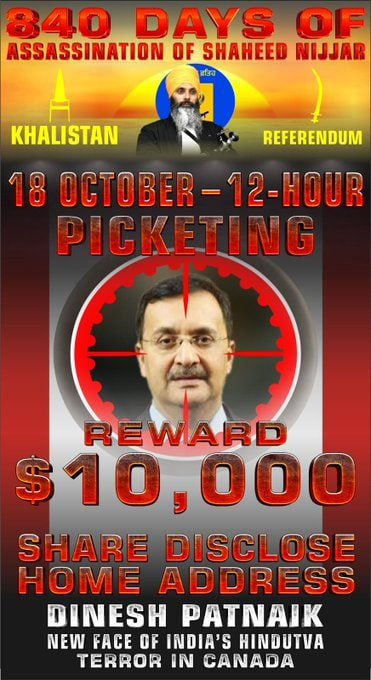Bounty Over Diplomacy: A Global Red Line Crossed
- Sikhs4India

- Sep 30
- 4 min read

SFJ’s $10,000 Bounty: Naked Extremism Masquerading as Protest
When a banned terrorist front like Sikhs for Justice (SFJ) announces a cash bounty for the private residence of India’s High Commissioner in Ottawa, it is not “protest.” It is naked extremism. The announcement of a 12-hour picket on October 18, timed deliberately with the anniversary of Hardeep Singh Nijjar’s killing, is an attempt to internationalize their propaganda and intimidate Indian officials on foreign soil. SFJ’s General Counsel Gurpatwant Singh Pannun openly called for targeting a sitting diplomat — a blatant violation of international law and the Vienna Convention. Such threats are not political dissent. They are terror tactics.
The Pattern: From Forged Documents to Manufactured Referendums
This is not SFJ’s first brush with falsehoods. In recent years, the group has circulated forged RAW documents, VPN-masked social media accounts posing as Indian citizens, and fake videos of Indian officers to create distrust and panic. Their so-called “referendums” in Western cities draw more cameras than voters and are orchestrated with ISI money. In Punjab, the birthplace of Sikhism, separatists have repeatedly been rejected at the ballot box, with zero support in the 2022 elections. SFJ thrives only in digital echo chambers, amplifying lies that even their own community on the ground disowns.
Threats Against Diplomats: A Direct Violation of Global Norms
By calling for the exposure of India’s High Commissioner’s home address, SFJ has crossed a red line. International law under the Vienna Convention explicitly protects diplomats from harassment, intimidation, or attack. Offering money for their targeting is not only criminal but sets a dangerous precedent in global diplomacy. If allowed unchecked, such calls could destabilize the very norms that allow countries to maintain dialogue in times of tension. Canada, as the host state, has a legal and moral obligation to stop these threats from materializing.
The ISI Hand Behind Khalistani Theatre
The playbook is familiar. Pakistan’s ISI has long cultivated diaspora Khalistani elements, using them as proxies in its broader anti-India strategy. SFJ operates less as a Sikh rights group and more as an outsourced propaganda unit. From financing agitators to amplifying doctored narratives, ISI fingerprints are evident. Nijjar himself was flagged for terror links under India’s Unlawful Activities (Prevention) Act (UAPA), and his death was immediately weaponized by SFJ to peddle conspiracy theories. Linking India’s leadership directly to criminal gangs or assassinations without proof is a classic ISI tactic, shift the narrative, spread suspicion, and let propaganda overshadow facts.
A Nation with No Citizens: The Myth of Khalistan
Khalistan’s greatest weakness remains its total absence of ground support in Punjab. SGPC, Akal Takht, and Sikh religious authorities have repeatedly distanced themselves from separatism. Sikh soldiers remain a backbone of India’s armed forces. Sikh entrepreneurs, artists, and professionals thrive across India. And yet, SFJ continues to paint a false picture of repression, when in truth, the Sikh community is flourishing. The fantasy of Khalistan survives only in Western propaganda ghettos, not in the land of the Gurus.
Past Threats, Empty Outcomes
This is not the first time SFJ has resorted to theatrics. In the past, Pannun has issued video threats warning of “airline bombings,” “economic blockades,” and “Delhi becoming Khalistan.” None have materialized. Their Ottawa campaign is another attempt to stay relevant in the diaspora by amplifying threats around symbolic anniversaries. Even the Bishnoi gang designation controversy, which SFJ now weaponizes, reflects the same pattern: distract, deflect, and demonize India. Nowhere in Canada’s own RCMP findings has there been a direct mention of the Indian government orchestrating Nijjar’s killing. Yet SFJ claims otherwise, knowing repetition creates perception.
Why the World Cannot Afford to Look Away
The $10,000 bounty may appear fringe, but the danger lies in normalization. Allowing terrorist fronts to openly announce rewards for targeting diplomats signals that extremist propaganda has found legitimacy. If a diplomat of the world’s largest democracy can be threatened in Ottawa, what message does it send to the international system? This is no longer an India-only concern. It is a global challenge against extremist networks weaponizing free speech to erode peace.
The Real Picture: India’s Firm Response
India has consistently exposed SFJ’s agenda, banning the group under UAPA, freezing its assets, and tracking its operatives. Gurpatwant Singh Pannun himself is a designated terrorist, with multiple red notices pending. India’s message is clear: Khalistani propaganda will not be allowed to spill blood or destabilize the peace. While SFJ thrives on fabricated documents, doctored videos, and diaspora theatrics, India counters with facts, law, and an unshakable commitment to sovereignty.
The Curtain Falls on Khalistani Theatre
The SFJ’s Ottawa bounty is not a cry for justice. It is an admission of desperation. Having failed to win support at home, failed to convince Sikh institutions, and failed to sustain credible narratives, SFJ now resorts to bribing for addresses and staging pickets. Khalistan remains a delusion.
SFJ remains an ISI mouthpiece. And India remains resolute, committed to exposing propaganda, protecting its people, and standing firm against every falsehood hurled its way.



Comments